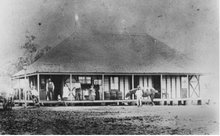The 1855 act that governed shipping conditions for migrants to Australia stipulated that each adult was to be allocated 130 gallons for the voyage. Queensland regulations required 214 gallons per adult. If the ship carried a water distilling device, this amount was halved. What this came down to was 3 quarts of water “exclusive of water for cooking” per adult per day. People were allowed higher allocations in the tropics if the supply was sufficient. However, German ships usually didn’t carry distilling equipment (which could produce 8 to 10 gallons per hour) and had a quota of one bottle (1-2 pints) per adult each day. Apparently the water wasn’t of good quality having been drawn from the Elbe.
130 gallons equals 591 litres.
214 gallons equals 973 litres
3 quarts equals 2.8 litres
1-2 pints are 0.5 to 1 litres
Compare this to the latest news that Brisbane water users are now the most frugal in the world beating out cities in Germany to “claim No. 1 spot.” Residents of Brisbane are averaging 123 litres of water per person each day. According to the article, US statistics are 380 litres a day and Britain’s 150 litres a day per person. This does include all water use, but can still be used as a simple comparison.
Consider the fact that we are urged to drink eight 250ml glasses of water a day, which is 2 litres. Consider that the passengers would be people unaccustomed to hot weather. Consider that the wine ration allowable under German maritime law was banned to the passengers “except for medicinal purposes.”
Feeling sorry for the passengers yet? Without downplaying the difficulties and hardships of the voyage, Woolcock argues that the “liberal dietary was probably far superior to what the majority of immigrants were accustomed. ‘It is like living on first class rations to a lot that are here’, observed one young man; while another declared they were eating ‘like Fighting Cocks.”
Subscribe to:
Post Comments (Atom)

No comments:
Post a Comment